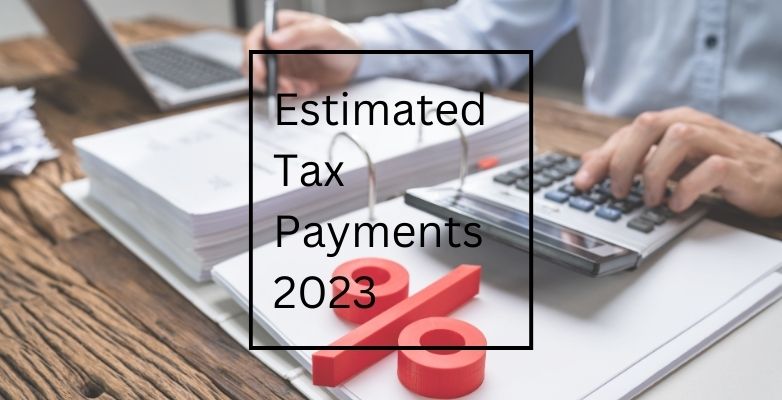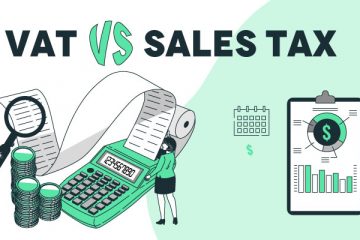The IRS has a policy of paying estimated tax under different criteria. If you are self-employed or a freelancer, even if you get your wages from any source, you come under the criteria of paying taxes. These taxes are supposed to be paid throughout the year. By paying your estimated taxes, you are somehow paying your income tax, self-employment tax, and even other taxes by how you earn your income. In this blog, we wish to explain all the useful information related to Estimated taxes.
Table of Content
What Are Estimated Taxes?
Estimated taxes are those taxes that are paid to the IRS from your whole year’s income. These taxes are not subjected to federal tax withholding. This can also include any self-business or your side freelance gigs. Any income that you’ve earned will be counted for your estimated quarterly tax.
According to the W4 Forms, most employers have their taxes withheld from their income. In other cases, you pay directly to the government according to their estimated tax. It is illogical to wait till the end of the year to pay your annual return.
Key Takeaways:
- Estimated taxes are quarterly payments of taxes for the year based on your reported income for the period.
- You may have to pay estimated taxes if you expect to owe $1,000 or more in tax when you file your annual tax return.
- You can use Form 1040-ES to figure out your estimated tax payments and make them online, by phone, or by mail.
- The tentative due dates for the estimated tax payments are April 15, June 15, September 15, and January 15 of the following year.
- If you do not pay enough estimated tax or pay late, you may be charged a penalty by the IRS.
Understanding Estimated Taxes
It is important for you to estimate your gross income, expenses, taxes, and deductions, this is one such way how you can figure out your estimated tax payments. To make your work easier, you can use the Form 1040-ES. It can help you in calculating the Estimated Tax. The Form 1040-ES also gives worksheets and payment vouchers.
You may have to pay estimated taxes if you expect to owe $1,000 or more in tax when you file your annual tax return. However, like every case, there might be certain exceptions. For example, paying your estimated tax is not compulsory if:
- There is no tax liability for the previous year.
- You were a U.S. citizen or resident alien for the whole year
- Your previous tax year covered a 12-month period
If you ask your employer to withhold more taxes, you can get free from paying the tax.. To do this, file a new Form W-4 with your employer and enter the additional amount you want them to withhold on line 4(c). You can use the Tax Withholding Estimator tool on the IRS website to help you determine how much extra withholding you need.
When Are Estimated Quarterly Taxes Due?
Depending upon the year you’re in, the Estimated Quarterly Taxes dates may vary. It is generally based upon the weekends and the holidays. The dates are usually around 15th April, 15th June, 15th September, and 15th January. The dates for this year, i.e. 2023 are:
- First quarter: April 18
- Second quarter: June 15
- Third quarter: September 15
- Fourth quarter: January 17
As we have advanced in technology, there is an online payments option too. You can make your estimated tax payments online using IRS Direct Pay, by phone using Electronic Federal Tax Payment System (EFTPS). You can also pay by mail using a check or money order along with a payment voucher from IRS Form 1040-ES. You can also pay with a credit or debit card through a third-party processor, but you may incur additional fees. In case of no payment or late payment there will be a penalty that will be charged by the IRS. The penalty may vary according to your interest rate on unpaid taxes. If you want to reduce your penalty, you should do the following things mentioned.
- Pay at least 90% of your current year’s tax liability or 100% of your previous year’s tax liability (110% if your adjusted gross income was more than $150,000)
- Pay your estimated tax by the due date of each payment period
- Use Form 2210, Underpayment of Estimated Tax by Individuals, Estates, and Trusts, to figure out your penalty amount and report it on your tax return.
Estimated Quarterly Payments Due 2023
| If you earned income during this period | Estimated tax payment deadline |
|---|---|
| Sept. 1 – Dec. 31, 2022 | Jan. 17, 2023* |
| Jan. 1 – Mar. 31, 2023 | April 18, 2023 |
| April 1 – May 31, 2023 | June 15, 2023 |
| June 1 – Aug. 31, 2023 | Sept. 15, 2023 |
| Sept. 1 – Dec. 31, 2023 | Jan. 16, 2024 |
Who should make estimated Quarterly Payments?
As per the guidelines given by IRS, You’re not supposed to pay estimated taxes if you’re a US citizen, a resident alien who owes no taxes as per the previous year income. If you taxed income, again you’re not supposed to pay the estimated quarterly payments. In case of untaxed payments, you have to pay.
The guidelines are different and vary according to your employment.
- People who don’t have much withheld: As per the IRS, you need to pay estimated taxes if:
- Even if you account for your withholding or refundable credits, you’ll still owe $1000 in federal income tax.
- Your withholdings and refundable credits will mostly cover 90% of your liability of this year and 100% of the following year.
- The self-employed: All self-employed people like independent contractors, freelancers, and people with side gigs come under this category. They are expected to pay more than $1000 in taxes or estimated quarterly taxes.
- Businesses: In case of a tax year, the corporations usually owe a lump sum amount of $500.
- Landlords and Investors: Despite having a rental income, it is still compulsory to pay estimated quarterly taxes.
How to Calculate Quarterly Estimated Tax?
Apparently there are multiple ways in which one can calculate quarterly estimated taxes. Depending upon your annual income, you need to decide on which method you’re supposed to use.
- Estimate based on previous year’s taxes: First you may estimate your early amount and then send one-fourth of that to the IRS. This system works best for people who have a consistent income throughout the year.
- Annualize: Based on what you’ve already managed to earn in the given year, you can estimate your quarterly tax. This system usually works for people whose income varies. The IRS has made a guidelines book to help you understand this better.
No matter which category you fall in IRS Form 1040 will guide you in estimating your income and tax liability. IRS publication 505 has mentioned all the rules and guidelines to guide you through the process.
However, if by chance you somehow overestimated or underestimated your earnings, you are supposed to complete another form called 1040-ES. This will help you to refigure your estimated tax. You most likely need to attach the form 2210, to explain why you didn’t send the original payments.
There are high chances that the calculations might get complicated, so it’s good to take help from the resources provided by the IRS.
How to Estimate Taxes for an Income Tax Extension?
If you do not fall under the category of someone who pays estimated quarterly taxes, but your return is not ready for tax as per the IRS rules, it is advisable for you to file an automatic six month tax extension request. This tax extension allows you to have extra time in order to assemble your paperwork together.
You can estimate your taxes by using the worksheet provided by the IRS form 1040-ES. Moreover, you can take help from tax calculators or software.
How to Pay Quarterly Estimated Tax Payments or Make Estimated Tax Payments?
There are many ways for making estimated tax payments, all this includes:
- The IRS online account.
- IRS2Go app
- IRS Direct pay.
- The US Treasury Electronic Federal Tax Payment System.
- Your Debit or Credit Cards.
- Cash payments (IRS Retail price).
Conclusion
Estimated taxes are a way of paying your income tax and other taxes as you earn or receive income during the year. They are required for people who have income that is not subject to withholding, such as self-employment, dividends, or capital gains. You can use Form 1040-ES to calculate your estimated tax payments and make them online, by phone, or by mail. The due dates for estimated tax payments are April 15, June 15, September 15, and January 15 of the following year. If you do not pay enough estimated tax or pay late, you may be charged a penalty by the IRS.
We hope this blog post has helped you understand what estimated taxes are and how to pay them. If you have any questions or need more information, please visit the IRS website or consult a tax professional.
Frequently Asked Questions
Can you Estimate your taxes anytime?
The IRS has set quarterly deadlines for their collection of taxes. You can choose to send four payments as per the IRS set schedule. You can start by paying smaller increments and then increase it according to your will. All you need to do is cover the tax liability before the deadline.
What happens if I forget to pay my quarterly tax?
In case you miss or forget to pay your quarterly charge, there will be consequences. The IRS will charge you a penalty which you will need to pay. To avoid this certain extra amount, it is advisable to clear your dues beforehand.
You can only be exempted from the penalties in only two situations:
1. You were under some casualty of a natural disaster.
2. You’re disabled or above the age of 62, and cannot pay the tax.
How can I make paying quarterly easier?
If you are someone who is married and both you and your spouse have a regular job and you are having your taxes withheld. You are liable to have as many taxes you need to cater your needs.




